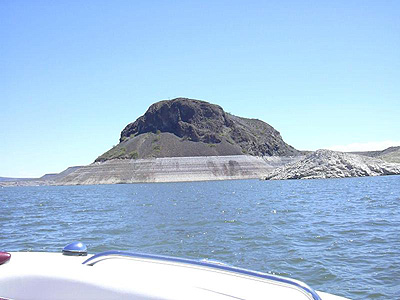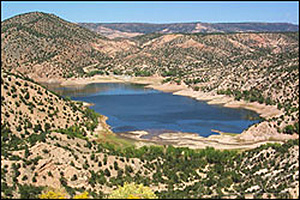LAKES Cochiti Lake New Mexico's Cochiti Lake can be found within the boundaries of the Pueblo de Cochiti Nation on the Rio Grande roughly 50 miles upstream from the city of Albuquerque. This New Mexico lake was created by the construction of Cochiti Dam, one of the 10 largest earth-fill dams in the United States. It contains over 65,000,000 cubic yards of earth and stone.
The Cochiti Recreation Area on the west side of the lake and the Tetilla Peak, on the east side of the lake, provide travel and recreational facilities for the public, including campsites, electrical hookups for RV's, picnic sites and shelters, restrooms and showers, drinking water and dump stations. Cochiti Lake also features universally accessible fishing areas, and boat launching ramps.
The Pueblo de Cochiti operates a modestly sized marina. There is also a visitor's center located on the west side of the lake, next to the operations building. https://visitusa.com/newmexico/lakes/index.htm
Elephant Butte Lake The name of Elephant Butte Lake, New Mexico's largest lake and the state's premier water recreation facility, comes from the weather-beaten core of a long-extinct volcano that is today an island in the reservoir, shaped, some think, like the eponymous pachyderm. The lake was constructed by a dam on the Rio Grande to provide irrigation and flood control. Elephant Butte Reservoir is some 40 miles long and boasts over 200 miles of shoreline.
Elephant Butte Lake is the most popular of the New Mexico lakes and a favorite destination year-round thanks to the unusually mild New Mexico climate in this area. The lake provides visitors with an opportunity to participate in almost every type of water sport, from fishing and swimming to boating and water-skiing.
Paleontology buffs will be interested to note that the lake is a prime fossil hunting ground. Elephant Butte Lake was once a shallow sea millions of years ago, and after that a prime hunting ground for the Tyrannosaurus Rex. Navajo Reservior Navajo Reservoir in New Mexico has a maximum surface area of 15, 610 acres (or 23 square miles) and provides important recreational New Mexico fishing and wildlife observation opportunities managed by the New Mexico State Parks. Like many man-made New Mexico lakes, the Navajo Reservoir's primary purpose is to provide irrigation water and flood control for the surrounding area. The reservoir is surrounded by rugged and attractive scenery. It features 5 public boat ramps and 3 marinas for guest out to do a little boating. Anglers are the most frequent visitors to the Navajo Reservoir thanks in part to its well-maintained fisheries. Game fish species found in the Navajo Reservoir include northern pike, catfish, smallmouth bass, rainbow trout, and Kokanee salmon. The 3-½ miles of the San Juan River below Navajo Dam are nationally renowned for their trophy-sized rainbow trout. Other species found here include German brown and cutthroat trout. https://visitusa.com/newmexico/lakes/index.htm Santa Cruz Lake Thirty miles north of Santa Fe, NM , the snow-fed waters of the Rio del Medio and the Rio Frijoles begin a 2,000-mile journey and a 7,000-foot descent to the Gulf of Mexico. For a time they gather at Santa Cruz Lake at the base of the Sangre de Cristo Mountains near Chimayo, behind the 125-foot Santa Cruz Dam. Built in 1929 by the Santa Cruz Irrigation District, the dam is 535 feet across and 90 feet deep at the overflowing spillway. The lake covers 121 surface acres with water in the foothills of the Sangre de Cristo Mountains, providing recreational opportunities for anglers, picnickers, campers, and boat lovers alike. Santa Cruz Lake Recreation Area is located on public land managed by the Bureau of Land Management (BLM). The Santa Cruz Irrigation District regulates water releases for agricultural use in the Santa Cruz Valley. The lake normally contains water year-round and may vary in depth as much as 30 feet. The local terrain is comprised of rugged, rolling foothills, with wide open mesas and chiseled steep canyons. The elevation at the lake is 6,285 feet and rises to 6,600 feet at the Overlook Campground. The eastern shoreline is fringed with juniper and pinon pine, cottonwood, and a filigree of mountain mahogany. The west side is dominated by a large buttress of granite. The climate at Santa Cruz Lake is semi-arid. Rainfall generally occurs from May through October with the bulk in July and August. Wind is primarily from the northeast during the winter, and southwest during the spring, summer, and fall. Summer temperatures range from 54-92 degrees and in the winter from 5-45 degrees. Page: https://www.nm.blm.gov/recreation/taos/santa_cruz_lake.htm Image: Eagle Nest Reservoir Eagle Nest is located in the Sangre de Cristo Mountains, nestled in the Moreno Valley between New Mexico's two highest peaks - Baldy Mountain (12,441 feet) and Wheeler Peek (13,161 feet) - at the junction of US Hwy 64 and State Hwy 38. Situated at 8,300 feet above sea level, the village offers high-country terrain, including mountains, valleys, ranch lands, and scenic vistas with pine, aspen, wildflowers, and clean air surounding beautiful Eagle Nest lake. The abundant wildlife in the area includes bear, elk, mountain cats, beavers, and -- yes -- eagles, both bald and golden.
The first inhabitants of the Moreno Valley were Native American tribes who freely roamed in search of game for food and golden feathers for ceremonial worship. Every fall they traveled to the valley where Angel Fire is today to renew themselves with the Great Spirit. In the late 1860s, when gold was struck, prospectors began arriving. It's estimated that over six million dollars of gold came from the mines in the surrounding areas, including Red River and Elizabethtown. The town of Eagle Nest first began as a ramshackle mining town, providing a homebase of sorts for the miners. During the mid to late 1800s, ranchers also moved cattle onto the open range of the Moreno Valley.
In the early 1900s, the Valley began to again change. Ranchers Charles and Frank Springer and the Cimarron Valley Land Company were granted Permit #71 in 1907 to impound the water of the Cimarron River for irrigation by building a dam. Construction on the dam began in 1916 and continued through 1918. It is thought to be the largest privately constructed dam in the United States. The concrete structure stands 140 feet above the creek bed, is 400 feet wide, and 9.5 feet thick at its crest and 45.2 feet thick at its base.
The dam created a reservoir covering 2,200 surface acres. The reservoir was named Eagle Nest Lake because of the eagles that nested in the area. Eagle Nest Lake was stocked with trout, and fishermen began to arrive. With the fishermen came entrepreneurs. Moreno Valley was transformed from a quiet farming community to a rough and rowdy town that catered to the entertainment of cowboys and tourists.
The town was originally named Therma - after the postal inspector's daughter. After mail continued to flow in addressed to Eagle Nest Lake, the town was renamed Eagle Nest in the 1930s. Today Eagle Nest still exemplifies the free-soaring spirit of the eagles that continue to rise above the community on the shores of nearby Eagle Nest Lake. And the surrounding mountains are still a source of life and commerce, treating visitors to year-round recreation – some of the best scenery, hiking trails, big game hunting, fishing, and snow skiing to be found anywhere. To the delight of ice fishermen, winter ice thickness on the Lake often reaches two and one-half to three feet.
Eagle Nest has its share of ghost stories, but it is far from a ghost town. As of December 1999, 60 businesses were registered with the Village Clerk, and the population is estimated at 300. Eagle Nest is the eastern gateway to the Enchanted Circle, and offers year-round accommodations in the center of northern New Mexico's mountain wonderland as well as skiing, hunting, fishing, boating, hiking, craft fairs, museums, shopping and many other activities to our visitors . A newly renovated main street with sidewalks and antique street lights offers numerous specialty shops and down-home restaurants.
|




